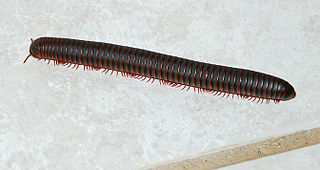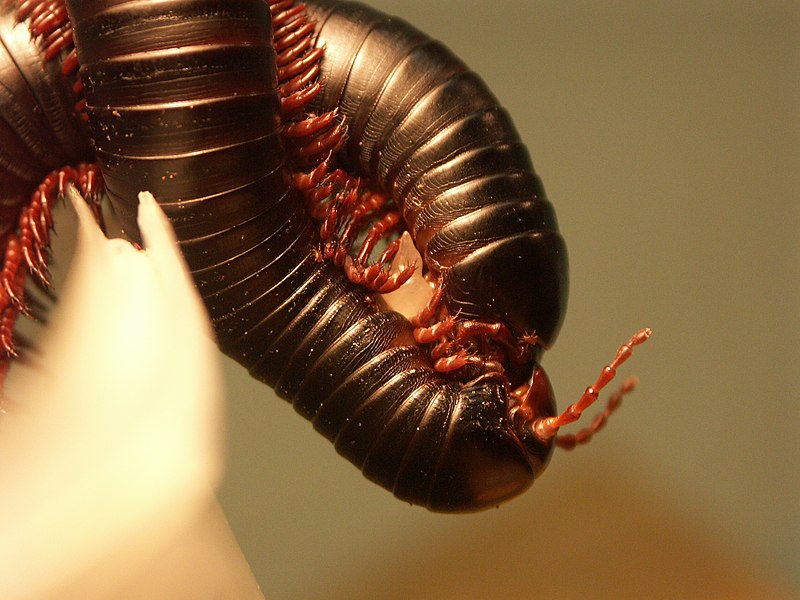Having been chased by a Kodiak bear, confronted by an escaped king cobra and otherwise molested by scores of formidable animals, I felt relatively secure in accepting responsibility for a group of arboreal South American millipedes entrusted to me by colleague about to travel abroad. A primatologist, she had observed capuchin monkeys to rub millipedes over their bodies, and was investigating the situation (I, on the other hand, have always been far more interested in millipedes than monkeys!).
Deadly Millipedes?
 A week after her departure, another coworker phoned me at 4 AM, frantically speaking in the rapid fire Spanish typical of her native Venezuela…and which I have great difficulty in grasping at 4 PM, much less 4 AM! Eventually I learned that 3 elderly millipede researchers had passed away recently, and that preliminary evidence indicated that cyanide poisoning, courtesy of the millipedes’ defensive chemicals, was suspected. I was warned against handling the millipedes (which I had been doing for weeks!) or putting them near my face (which I do not do with any creature).
A week after her departure, another coworker phoned me at 4 AM, frantically speaking in the rapid fire Spanish typical of her native Venezuela…and which I have great difficulty in grasping at 4 PM, much less 4 AM! Eventually I learned that 3 elderly millipede researchers had passed away recently, and that preliminary evidence indicated that cyanide poisoning, courtesy of the millipedes’ defensive chemicals, was suspected. I was warned against handling the millipedes (which I had been doing for weeks!) or putting them near my face (which I do not do with any creature).
The deaths turned out to be coincidental and unrelated to millipedes, but the incident led to a good deal of research into the defensive chemicals produced by these popular terrarium pets. It seems that millipede toxins are a very unique and complicated group of compounds.
Exploiting Millipede Toxins
Interestingly, a number of species of frogs and monkeys harness these chemical weapons for their own use. Although lagging behind such creatures by a few million years, humans are also getting into the act, and we may soon be putting millipede secretions to medicinal use.
An Amazing Coincidence!!!
The incident I related above, concerning myself and the millipedes, transpired approximately 8-10 years ago. I’m not sure why I decided to write about it today, but I’ve had millipede articles on my mind for some time, and thought this would make a nice introduction to the topic.
After writing this article I searched for a reference to add, for those readers who wished to learn more. You can imagine my shock when I discovered that today’s NY Times (28 June 2009) carries an article about the very same monkeys, people and millipedes involved in my story!!!
To read the entire article, please go to http://www.nytimes.com/2000/12/05/science/05MONK.html?pagewanted=print.
Next time I’ll explore the nature of these defensive weapons and the uses that monkeys, frogs and people are finding for them. Following that we’ll take a look at keeping and breeding millipedes in captivity.
Image referenced from Wikipedia and originally posted by Prashanthns.
 That Reptile Blog – Reptile, Amphibian and Exotic Pet Care and Information
That Reptile Blog – Reptile, Amphibian and Exotic Pet Care and Information


 and in the hopes of providing as many nutrients as possible, I began offering African giant millipedes a wide variety of food items. With the help of colleagues here and abroad, I eventually arrived at a diet that has allowed me to breed a number of native and exotic millipedes, and to maintain individual animals for over 10 years.
and in the hopes of providing as many nutrients as possible, I began offering African giant millipedes a wide variety of food items. With the help of colleagues here and abroad, I eventually arrived at a diet that has allowed me to breed a number of native and exotic millipedes, and to maintain individual animals for over 10 years. It seems that millipedes of many types (there are over 10,000 species described to date) mix hydrogen cyanide, quinones, phenols and aldehydes with enzymes to create toxic defensive sprays and secretions. In fact, tiny millipedes consumed by poison frogs (Dendrobates spp.) account for some if not most of the virulent skin toxins found in the skins of these colorful amphibians.
It seems that millipedes of many types (there are over 10,000 species described to date) mix hydrogen cyanide, quinones, phenols and aldehydes with enzymes to create toxic defensive sprays and secretions. In fact, tiny millipedes consumed by poison frogs (Dendrobates spp.) account for some if not most of the virulent skin toxins found in the skins of these colorful amphibians.  to keep the animals away from one’s face. Stressed millipedes confined in airtight containers have been known to expire from the concentrated effects of their own toxins.
to keep the animals away from one’s face. Stressed millipedes confined in airtight containers have been known to expire from the concentrated effects of their own toxins. A week after her departure, another coworker phoned me at 4 AM, frantically speaking in the rapid fire Spanish typical of her native Venezuela…and which I have great difficulty in grasping at 4 PM, much less 4 AM! Eventually I learned that 3 elderly millipede researchers had passed away recently, and that preliminary evidence indicated that cyanide poisoning, courtesy of the millipedes’ defensive chemicals, was suspected. I was warned against handling the millipedes (which I had been doing for weeks!) or putting them near my face (which I do not do with any creature).
A week after her departure, another coworker phoned me at 4 AM, frantically speaking in the rapid fire Spanish typical of her native Venezuela…and which I have great difficulty in grasping at 4 PM, much less 4 AM! Eventually I learned that 3 elderly millipede researchers had passed away recently, and that preliminary evidence indicated that cyanide poisoning, courtesy of the millipedes’ defensive chemicals, was suspected. I was warned against handling the millipedes (which I had been doing for weeks!) or putting them near my face (which I do not do with any creature).